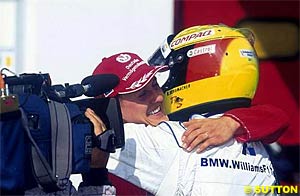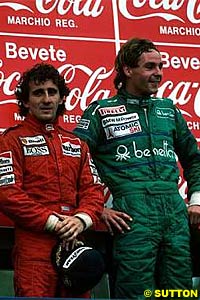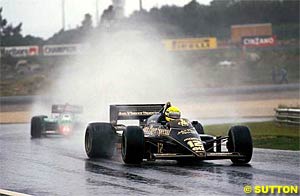
Atlas F1 Magazine Writer
What are the chances of Michael Schumacher being beaten in the upcoming San Marino Grand Prix? How well has Michelin performed on the track in pre-season testing? What do Gerhard Berger and JJ Lehto have in common? And what happened 19 years ago this week? Marcel Schot brings the answers and more anecdotes on the fourth round of the season
Having achieved seven consecutive poles, the German missed out on equaling Ayrton Senna's record from 1988/89. Schumacher only qualified fourth but didn't seem too disappointed. Disappointment did, however, come in the race. After a bad start, the Ferrari driver dropped back to eighth place. A few laps later he passed Olivier Panis for seventh, but before the race was halfway through, Schumacher's left front suspension gave way, leaving Michael on the sideline to watch his brother score his maiden victory.
While Ferrari are clearly the team to beat, several teams behind them are putting in solid performances. BAR so far are the revelation of 2004 with already two podium finishes for Jenson Button. Renault are also going strong with nine consecutive races in the points. Nine races in the points was also what McLaren had before both cars retired in Bahrain.
Whether Ferrari can be beaten, depends for a large part on the performance of the Michelin tyres. Looking at the past years at Imola doesn't give much hope in that respect. Even with the majority of the points finishers in the last two years on Michelins, Ferrari had both cars on the podium and, more importantly, won both races. Michelin did win in 2001, but Ralf Schumacher then was the only Michelin shod driver to score.
The two big tests on Imola in February this year didn't show much to warrant different expectations. While Renault were strong in the first three-day test, Sauber as well as Ferrari's test driver Luca Badoer weren't too far away. During the second test at the end of February, Michael Schumacher was a lot faster than anyone else. Even when testing results don't always show the true perspective, the Michelin teams clearly didn't have an edge in Imola so far.
Two of a kind
How different two careers can go while also having similarities is easily shown by starting with the first podium finishes of Gerhard Berger and JJ Lehto. Both scored their first podium finish at Imola - Berger in 1986 with Benetton and Lehto five years later for Dallara. While it was the only podium finish of Lehto's career, Berger went up the stairs no less than 48 times.
After four races with ATS in 1984 and a season with Arrows, Gerhard Berger moved to Benetton for 1986. The Austrian started the season successfully with two sixth places in Brazil and Spain. Only Berger and Championship leader Ayrton Senna drove the first two races in the points. Thus Berger went to Imola with some confidence. Qualifying wasn't exactly earth-shattering, but after having scored points from respectively 16th and seventh in the first races, a ninth place on the grid didn't worry Berger too much.
Then the problems started. The clutch stopped working and Berger struggled on, losing ground to those behind him and rapidly dropping back down to ninth as Arnoux, Patrese, Fabi and Johansson passed him. Then the new fuel rules started to come in effect. With no refueling allowed, the tanksize limited from 220 to 195 litres and a traditionally thirsty Imola, one driver after the other ran into problems. Many drivers had to back off and for some of them even that didn't help.
Both Patrese and Rosberg ahead of Berger ran out of fuel. Johansson had to back off as well and both Fabi and Ferrari driver Michele Alboreto retired, handing Berger third place. For a while Berger charged for second. He even managed to unlap himself, but when he realised that the extra lap might have him run out of fuel as well, he settled for third and let Alain Prost lap him again.
With that third place, Berger scored his first podium and remained the only driver in the Championship that year to had scored points in all races.
For JJ Lehto things went a bit different. First of all he was with a team that generally didn't score many points. Driving for Dallara meant taking part in pre-qualifying at eight in the morning on Friday. Only the first four of the eight drivers were allowed to continue their weekend. This proved no problem for Lehto. He finished the session in second, between the two Jordans.
Later on the Friday the first qualifying session took place. While Lehto, as pre-qualifier, should have been near the back of the field, he did very well and finished 16th. The Finn impressed again in the Saturday session, but his eighth place didn't put him anywhere on the grid as the session was driven on a wet track.
On Sunday Lehto had already won a place before the race started. Alain Prost spun off the wet track in the warm up lap and wasn't able to start. During the opening lap, the slippery track caused more problems as Nigel Mansell and Martin Brundle collided and both Nelson Piquet and Jean Alesi spun off. When the track started to dry after a few laps, Lehto was up into tenth place. Problems for Morbidelli and Patrese meant eight place shortly before the pitstops.
After everyone had pitted, Lehto resumed his eighth place and gradually moved up. First past Julian Bailey in the Lotus and then past Ligier driver Thierry Boutsen into the points. A few laps later Ivan Capelli retired from fifth. This left Lehto in a position where he had little threat from behind - as Andrea de Cesaris was 13 seconds down in the Jordan - and not much to gain in the front, where Roberto Moreno was 20 seconds in the clear. Happy with two points looming on the horizon, Lehto proceded to finish the race without much excitement.
However, without having to do much himself, Lehto moved up further when Stefano Modena retired with transmission problems. As the end of the race got closer, the gap towards Moreno went smaller and smaller. The Brazilian had lost half his gears, eventually blowing his engine when the revs got too high. This gave Lehto the unexpected excitement of finishing in third for his first and only podium.
This week in history
19 years ago, on Sunday 21 April 1985, it rained in Estoril. This set the scene for the debut victory of Ayrton Senna. After a year at Toleman, the Brazilian was aware that the team wasn't his stepping stone to world fame and for 1985 he moved to Lotus. His debut race for the black and gold team in his native Brazil ended in retirement. But during practice in Portugal Senna set the tone rightaway.
On Sunday the rain came pouring just as the race was about to start. Both Lotuses got underway very well and their domination was clear from the beginning. Senna felt like a fish in the water on the drenched track and after four laps he was nearly five seconds away from de Angelis and almost ten ahead of Alain Prost, who had moved into third with his McLaren. After that de Angelis slowly lost touch and by lap nine Prost was on his tail. Meanwhile Senna went on as if the track was completely dry and driveable. Backmarker after backmarker looked in their mirrors in sheer amazement at how quickly the black Lotus caught up with them.
After 13 laps Senna settled in a rhythm that gave him the same laptimes as his followers, some 15 seconds behind him; the lead was comfortable and there was no need to take risks. De Angelis was still holding up Prost and behind them only Michele Alboreto in the Ferrari could remain in sight. After 18 laps the weather got worse, but again it didn't bother Senna much. In two laps' time, the Brazilian extended his lead by ten seconds. By lap 22 only the top six were on the same lap, and five laps later reigning World Champion Niki Lauda was the next to be passed by the flying Lotus driver.
Halfway through the race Senna led by 42 seconds over de Angelis. Alboreto was now third after Prost had run into problems. The Italian was seven seconds behind the second Lotus. Renault driver Patrick Tambay was the only other driver on the lead lap, nearly a minute and a half behind Senna. While even Senna had his problems every now and then, his pace was in a different league from the rest of the field. After 47 laps only three cars remained in the same lap and none was within a minute of the leader. Another ten laps later and only Alboreto was in the same lap as Senna. Even de Angelis wasn't able to maintain his early pace, as he dropped back to third.
After two hours the chequered flag was waved and after 67 laps around Estoril, Ayrton Senna celebrated his first victory. The Brazilian had driven a historic race, leading from start to finish in difficult circumstances and completely annihilating the competition in the process. On that day in April, the young Brazilian put his mark on Formula One and set the tone for the coming years.
With a race in Australia and two in Asia behind us, it's now time to move the focus of Formula One to Europe. The first race on the old continent is the San Marino Grand Prix, as it has been since 1997. The circuit at Imola, 60 miles north-west of San Marino, has in recent years been dominated by the Schumacher brothers. Michael has won the race in 1999, 2000, 2002 and 2003, while Ralf won the 2001 event.
 In similar fashion to other circuits, Ferrari's statistics at Imola over the past few years are superb. In the last ten years, the team from Maranello scored four wins and 15 podium finishes. However, inbetween his four wins, Michael Schumacher had a bad experience in 2001.
In similar fashion to other circuits, Ferrari's statistics at Imola over the past few years are superb. In the last ten years, the team from Maranello scored four wins and 15 podium finishes. However, inbetween his four wins, Michael Schumacher had a bad experience in 2001.
 At the start things didn't go very well for Berger. Both his teammate Teo Fabi and Lola driver Patrick Tambay made their way past the Austrian. A lap later he moved back into tenth place as Nigel Mansell ran into problems that eventually ended the Briton's race. After five laps Berger was back at his starting position when Tambay retired. After that, Berger continued his upward trend. First he overtook Ferrari driver Stefan Johansson, then Senna retired and a few laps later both Ligier drivers lost a lot of time. The Benetton driver now quickly caught up with his teammate and after 19 laps moved into fifth place, where he remained until shortly after half distance.
At the start things didn't go very well for Berger. Both his teammate Teo Fabi and Lola driver Patrick Tambay made their way past the Austrian. A lap later he moved back into tenth place as Nigel Mansell ran into problems that eventually ended the Briton's race. After five laps Berger was back at his starting position when Tambay retired. After that, Berger continued his upward trend. First he overtook Ferrari driver Stefan Johansson, then Senna retired and a few laps later both Ligier drivers lost a lot of time. The Benetton driver now quickly caught up with his teammate and after 19 laps moved into fifth place, where he remained until shortly after half distance.
 After the first qualifying session on Friday, Senna was on provisional pole, six tenths quicker than teammate Elio de Angelis and nearly two seconds quicker than number three Niki Lauda in the McLaren. While the competition became faster on Saturday, Senna struck them all by going no less than seven tenths quicker than the day before. This gave the Lotus driver the first of his 65 pole positions, a record which still stands today.
After the first qualifying session on Friday, Senna was on provisional pole, six tenths quicker than teammate Elio de Angelis and nearly two seconds quicker than number three Niki Lauda in the McLaren. While the competition became faster on Saturday, Senna struck them all by going no less than seven tenths quicker than the day before. This gave the Lotus driver the first of his 65 pole positions, a record which still stands today.
|
Contact the Author Contact the Editor |
Please Contact Us for permission to republish this or any other material from Atlas F1.
|
Volume 10, Issue 16
Atlas F1 Exclusive
Interview with Bob Bell
Interview with Gianmaria Bruni
Articles
Every Other Sunday
The Paint Job: Part V
2004 San Marino GP Preview
2004 San Marino GP Preview
San Marino GP Facts & Stats
Columns
The F1 Trivia Quiz
Rear View Mirror
Bookworm Critique
On the Road
Elsewhere in Racing
The Weekly Grapevine
> Homepage |